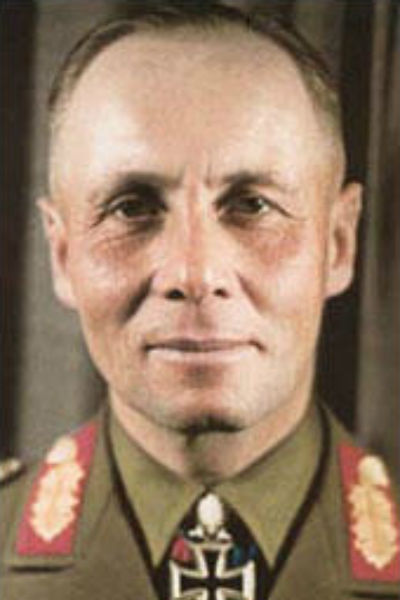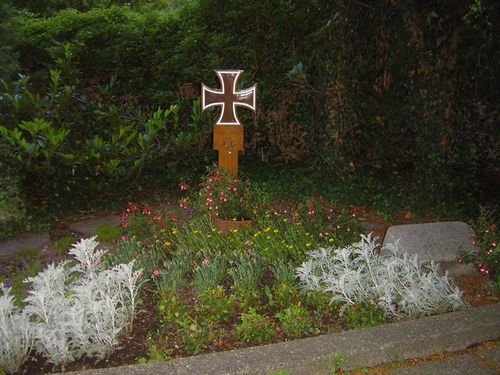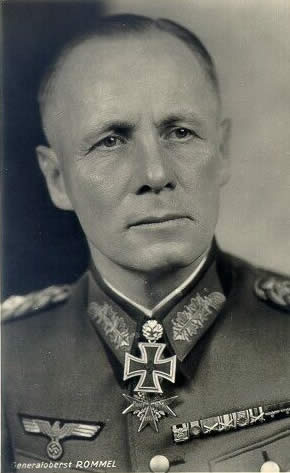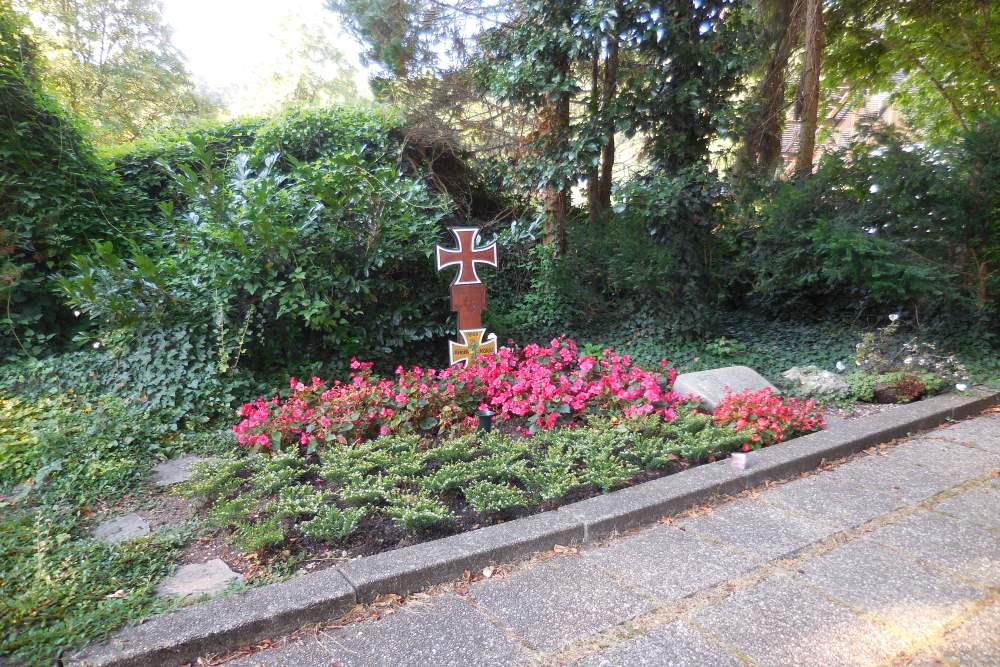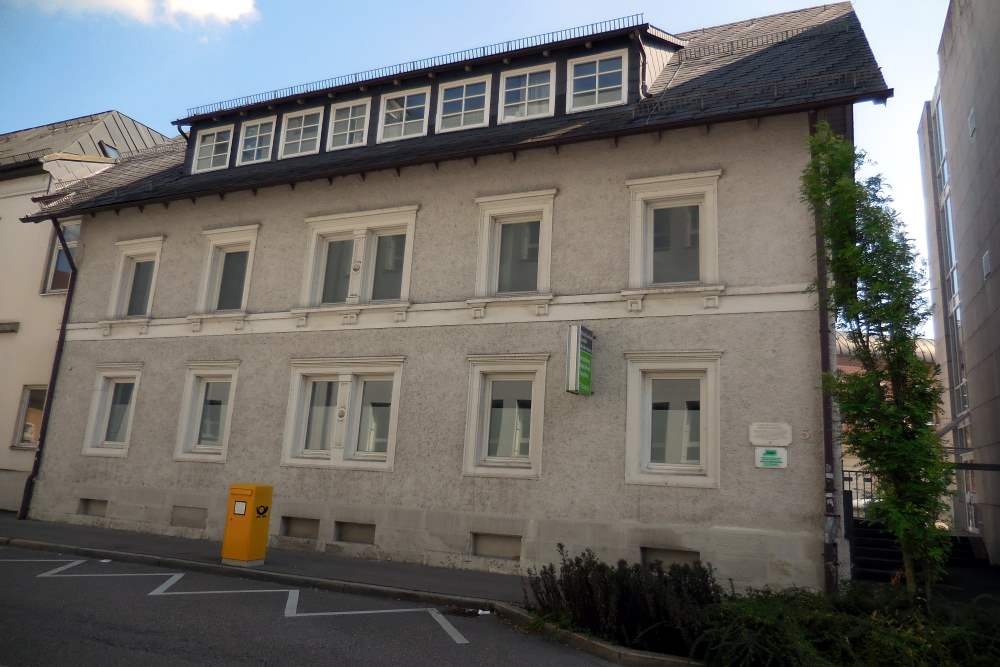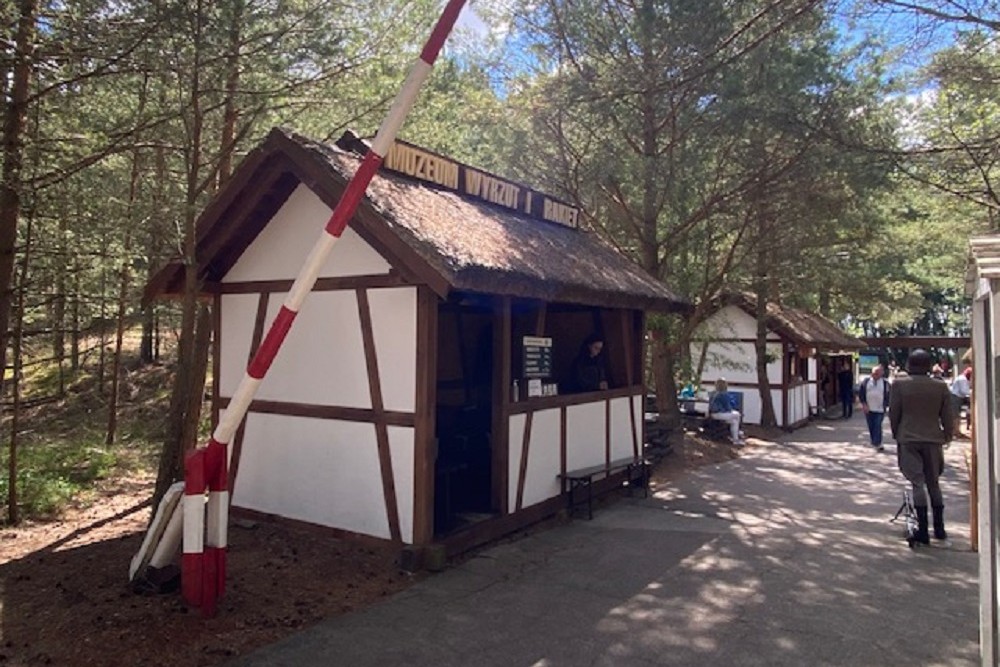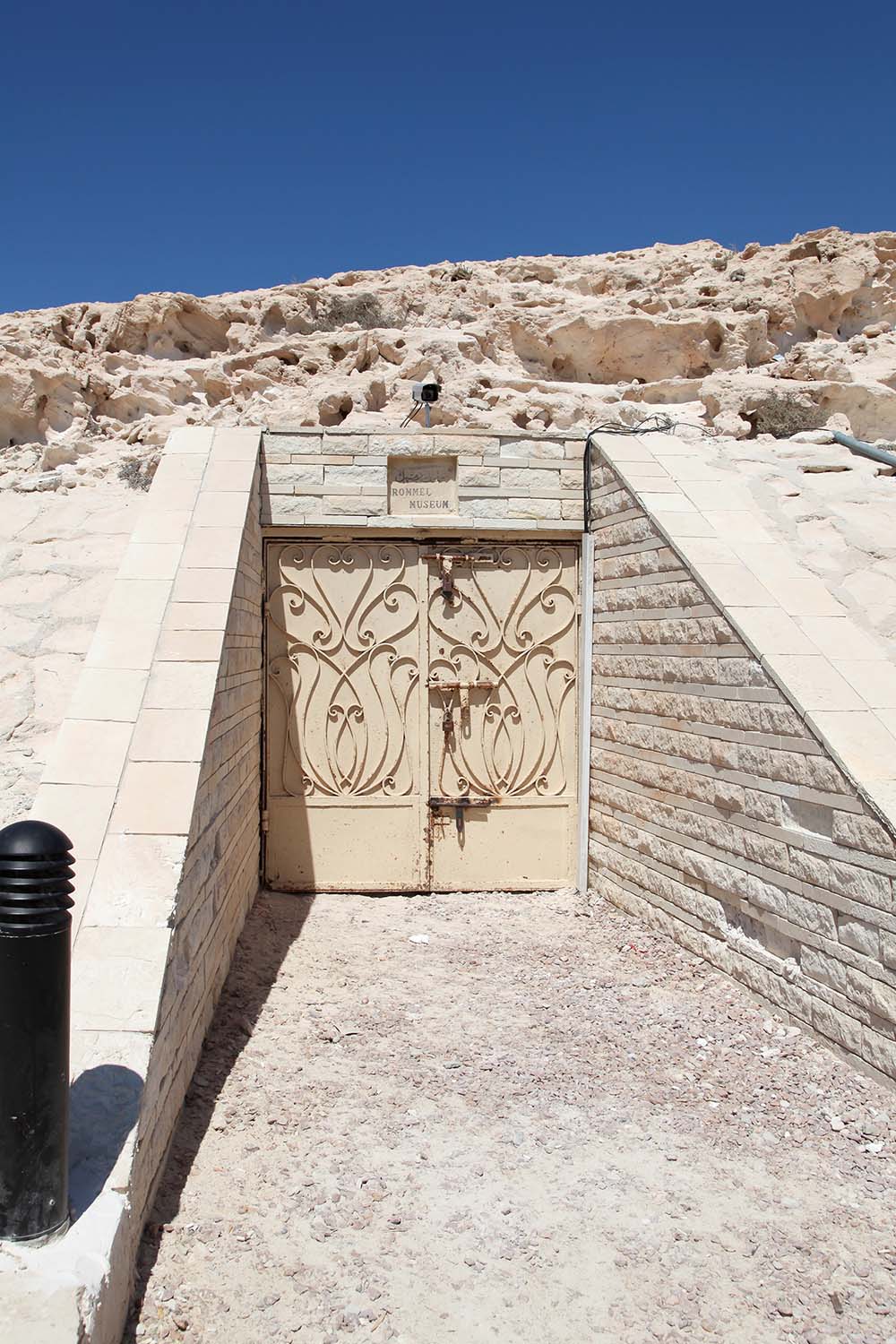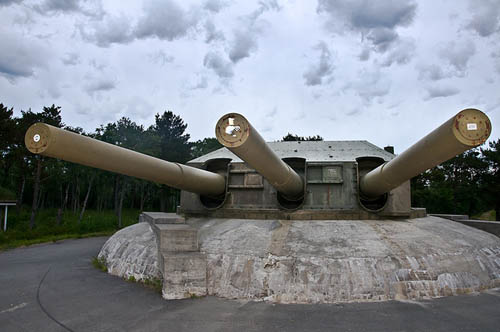Rommel, Erwin Johannes Eugen
- Date of birth:
- November 15th, 1891 (Heidenheim/Württemberg, Germany)
- Date of death:
- October 14th, 1944 (Herrlingen/Württemberg, Germany)
- Buried on:
- Grave Erwin Rommel
- Nationality:
- German
Biography
Erwin Johannes Eugen Rommel was born in Heidenheim, near Ulm, Germany on November 15th 1891. He dreamed of pursuing a career in technology but instead joined the 124.Infantry-Regiment (6 Wurttemberg) as a cadet in 1910. The following year he was allowed to go to the Officers School in Gdansk and in 1912 returned to his regiment in Weingarten as an officer. Rommel was actively engaged in World War I. He was injured in 1914 and in 1917 was awarded the highest German decoration, Pour le Mèrite, which was usually reserved for generals. At the end of the war, he was employed as a staff officer.
Between the wars Rommel held several military positions. In October 1933 he was promoted to Major and in November 1935 to Lieutenant-Colonel and became a teacher at the Military Academy in Potsdam. In November 1938, he assumed command of the Military Academy at Wiener Neustadt. September 1939 saw him promoted to Major-General and he took command of Hitler's personal guards during the Polish campaign.
In May 1940, during the invasion of France, he was in command of the 7. Panzer-Division, which earned the nickname the "Ghost Division" because of its lightning advances and great victories. January 1941 saw Rommel promoted to Lieutenant-General and placed in command of the newly-established German Afrika Korps (DAK), which left for Tripoli, North Africa on February 12th with the mission of rendering assistance to the Italian forces in their struggle against the British. Initially, he scored great victories over the British, which earned him the nickname "Desert
Fox", and a promotion to General Field Marshall; at the age of 51 the youngest in the Wehrmacht. At El Alamein; however, he had to succumb to the British 8th Army under General Montgomery. His Afrika Korps was driven all the way back to Tunisia and on 19 February 1943, he scored his last great victory in North Africa over the American II Corps at Kasserine.
At the end of February, he named General Hans-Jürgen von Armin as his successor and returned to Germany on sick leave. On March 11th 1943, he was awarded the Oakleaves, Swords and Diamonds to his Knight's Cross by Hitler personally.
Following postings in Greece and Italy, where he was succeeded by Albert Kesselring, he was put in command of Heeresgruppe B in Normandy under Oberbefehlshaber West (Commander-in-Chief) Gerd von Rundstedt. After the successful Allied landings of 6 June and the subsequent swift advances, Rommel thought continuation of the war pointless and he wasn't alone. On 20 July, in Hitler’s Rastenburg Headquarters in East Prussia, an unsuccessful assassination attempt was made on Hitler’s life. Three days before, Rommel had been seriously injured in an Allied air attack near Livarot. Rommel had not been actively engaged in the plot against Hitler but he was aware of it and during the interrogation of one of the plotters, Rommel’s name was mentioned. Consequently, Rommel was presented with two choices: either stand trial as a traitor with subsequent grave danger to his family or commit suicide. On October 14th Rommel choose the latter option. He was given a state funeral with full military honors on 18 October and buried in Ulm, Germany.
Promotions:
• Fahnenjunker: 19 July 1910
• Leutnant: 27 January 1912 – Patent 30 January 1910
• Oberleutnant: ? September 1915
• Hauptmann: 18 October 1918 (34)
• Major: ? April 1932
• Oberstleutnant: 1 March 1935
• Oberst: 1 August 1937
• Generalmajor: 1 August 1939 – RDA 1 June 1939
• Generalleutnant: 1 January 1941
• General der Panzertruppe: 1 July 1941
• Generaloberst: 30 January 1942
• Generalfeldmarschall: 22 June 1942
Do you have more information about this person? Inform us!
- Period:
- First World War (1914-1918)
- Rank:
- Leutnant (2nd Lieutenant)
- Awarded on:
- September 30th, 1914
- Period:
- First World War (1914-1918)
- Rank:
- Leutnant (2nd Lieutenant)
- Awarded on:
- February 25th, 1915
- Period:
- First World War (1914-1918)
- Rank:
- Leutnant (2nd Lieutenant)
- Awarded on:
- March 22nd, 1915
- Period:
- First World War (1914-1918)
- Rank:
- Leutnant (2nd Lieutenant)
- Awarded on:
- April 8th, 1915
Upon award of the Knight’s Cross of the Württemberg Military Merit Order and in accordance with the Kingdom’s award regulations, he was no longer entitled to display the golden medal and it was stricken from his records.
- Period:
- First World War (1914-1918)
- Rank:
- Oberleutnant (1st Lieutenant)
- Awarded on:
- December 10th, 1917
Details: Rommel was one of the rare Pour le Mérite recipients who did not receive the Knight’s Cross with Swords of the Prussian Royal Hohenzollern House Order – the customary World War I “stepping stone” between the Iron Cross, 1st Class and the Pour le Mérite Order. Ferdinand Schörner was another recipient of the Pour le Mérite who never received the Hohenzollern.
- Period:
- Second World War (1939-1945)
- Rank:
- Generalmajor (Brigadier)
- Awarded on:
- May 17th, 1940
Had already received the Iron Cross 2nd Class on September 30th 1914.
- Period:
- Second World War (1939-1945)
- Rank:
- Generalmajor (Brigadier)
- Awarded on:
- May 21st, 1940
Had already received the Iron Cross 1st Class on March 22nd 1915.
- Period:
- Second World War (1939-1945)
- Rank:
- Generalmajor (Brigadier)
- Unit:
- Kommandeur 7.Panzer-Divison
- Awarded on:
- May 27th, 1940
“Generalmajor Erwin Rommel had a key role to play in the swift breakthrough of the extended Maginot Line. While leading at the head of a Panzer-Regiment, he personally rushed far ahead of his Division, smashed 2 enemy divisions with his troops, captured a great number of prisoners and captured a massive quantity of all manner of weapons and war materiel. His feats on the battlefield resulted in this General having a decisive influence on the conduct of the major operations in the West.”
This text refers to Rommel’s swift breakthrough of the French border defenses SE of Maubeuge and the subsequent advance towards Landrecies on 18.05.1940. In the process Rommel and his troops were able to wipe out 2 Allied divisions and take 4000 prisoners.
43rd Award.
- Period:
- Second World War (1939-1945)
- Rank:
- Generalleutnant (Major-general)
- Unit:
- Kommandeur 7.Panzer-Division
- Awarded on:
- March 20th, 1941
10th Award.
- Period:
- Second World War (1939-1945)
- Rank:
- Generalleutnant (Major-general)
- Unit:
- Kampfgruppe DAK
- Awarded on:
- April 22nd, 1941
Presented by Generale d’Armata Italo Gariboldi on 22 April 1941.
- Period:
- Second World War (1939-1945)
- Rank:
- General der Panzertruppen (Lieutenant-General of Armoured Forces)
- Awarded on:
- January 15th, 1942
- Period:
- Second World War (1939-1945)
- Rank:
- General der Panzertruppen (Lieutenant-General of Armoured Forces)
- Awarded on:
- January 15th, 1942
- Period:
- Second World War (1939-1945)
- Rank:
- General der Panzertruppen (Lieutenant-General of Armoured Forces)
- Unit:
- Befehlshaber der Panzer-Gruppe Afrika
- Awarded on:
- January 20th, 1942
6th Award.
- Period:
- Second World War (1939-1945)
- Rank:
- General der Panzertruppen (Lieutenant-General of Armoured Forces)
- Awarded on:
- April 28th, 1942
Presented by Generale d’Armata Ettore Bastico on 28 April 1942.
- Period:
- Second World War (1939-1945)
- Rank:
- Generaloberst (General)
- Awarded on:
- June 21st, 1942
- Period:
- Second World War (1939-1945)
- Rank:
- Generalfeldmarschall (Field Marshall)
- Unit:
- Oberbefehlshaber der Heeresgruppe Afrika
- Awarded on:
- March 11th, 1943
6th Award.
- Period:
- Second World War (1939-1945)
- Rank:
- Generalfeldmarschall (Field Marshall)
- Awarded on:
- September 10th, 1943
- Period:
- Second World War (1939-1945)
- Rank:
- Generalfeldmarschall (Field Marshall)
- Awarded on:
- July 12th, 1944
Royal Decree No. 1297
- Period:
- Second World War (1939-1945)
- Rank:
- Generalfeldmarschall (Field Marshall)
- Awarded on:
- July 12th, 1944
Royal Decree No. 1297
- Period:
- Second World War (1939-1945)
- Rank:
- Generalfeldmarschall (Field Marshall)
- Awarded on:
- August 7th, 1944
- Period:
- First World War (1914-1918)
- Period:
- First World War (1914-1918)
- Period:
- First World War (1914-1918)
- Period:
- First World War (1914-1918)
- Period:
- Second World War (1939-1945)
- Period:
- Second World War (1939-1945)
- Period:
- Second World War (1939-1945)
- Period:
- Second World War (1939-1945)
- Period:
- Second World War (1939-1945)
- Period:
- First World War (1914-1918)
- Period:
- First World War (1914-1918)
Sources
- Photo 1: Willi Schumacher Collection/Norbert Beyerlein
- Photo 2: Norbert Beyerlein
- - THOMAS, FRANZ & WEGMANN, GüNTER, Die Eichenlaubträger 1940-1945, Biblio-Verlag, 1998.
- Kwasny A., Kwasny G., Die Eichenlaubträger 1940-1945 (CD), Deutsches Wehrkundearchiv, Lage-Waddenhausen, 2001
- Fellgiebel W.P., Elite of the Third Reich, The recipients of the Knight's Cross of the Iron Cross 1939-1945: A Reference, Helion & Company Limited, Solihull, 2003, ISBN 1-874622-46-9
- Kursietis A.J., The wehrmacht at war 1939-1945 the units and commanders
- Wehrmacht Awards
- Biography of Rommel - Axis History Forum
- Die Tapfersten
Photos
Background stories
The War Illustrated
- 12-'41: The Battle of Libya: The First Phase
- 06-'42: Along the Battle Fronts
- 06-'42: The War in the Air
- 06-'42: The War at Sea
- 07-'42: The War in the Air
- 07-'42: The War in the Air
- 08-'42: Along the Battle Fronts
- 08-'42: Along the Battle Fronts
- 04-'43: Knocked Out? Tanks Today Have Nine Lives!
- 04-'43: How Montgomery Captured the Mareth Line
- 10-'43: Movie-Cameramen in the Front Line of Battle
- 07-'44: The Battle Fronts
- 07-'44: The War in the Air
- 07-'44: The Battle Fronts
- 12-'46: The Daring Raid on Rommel's H.Q.


































